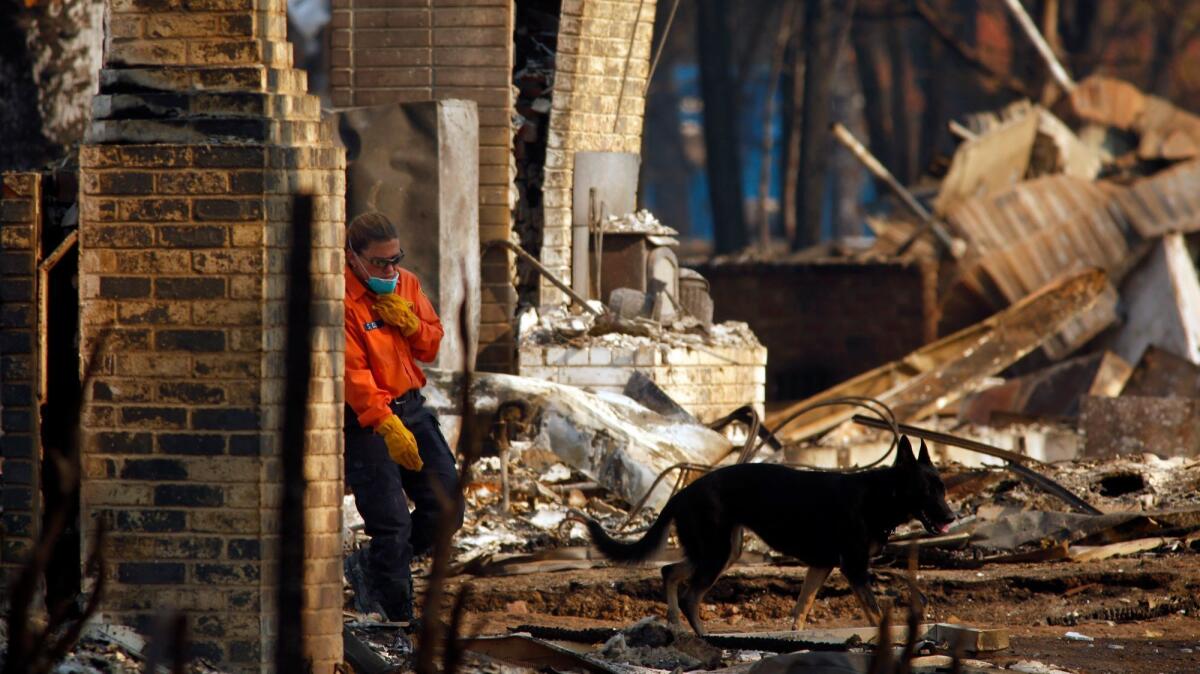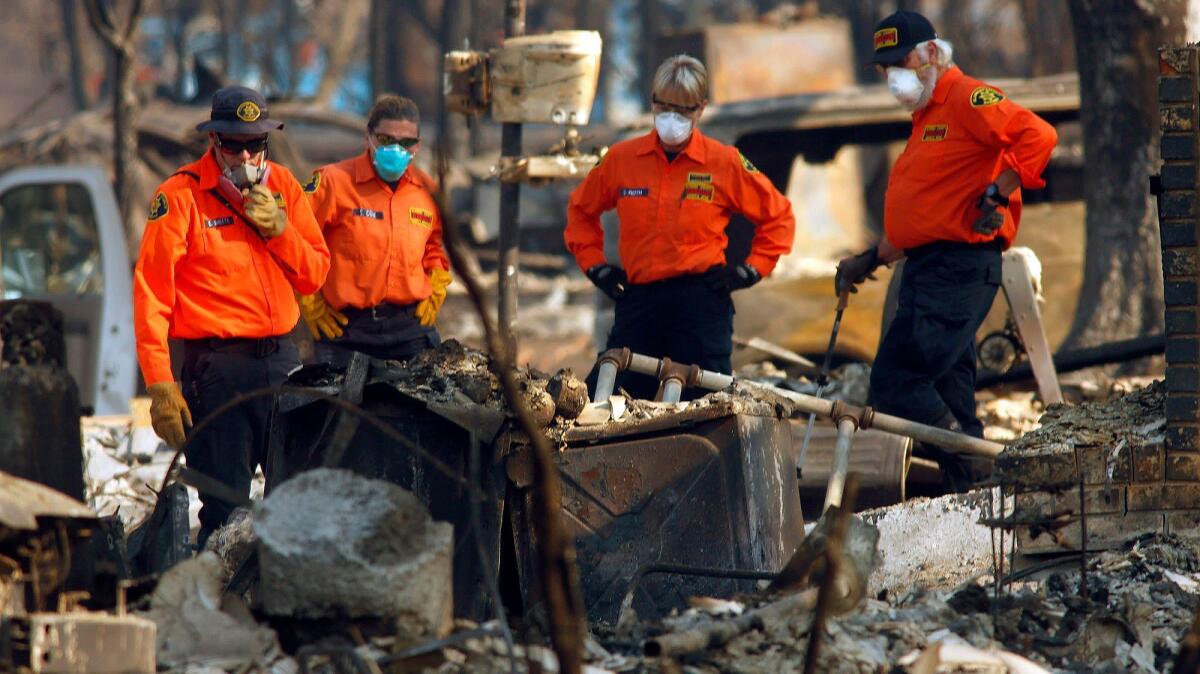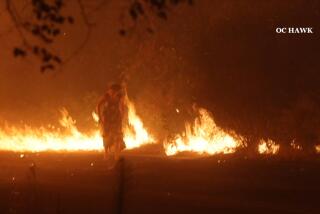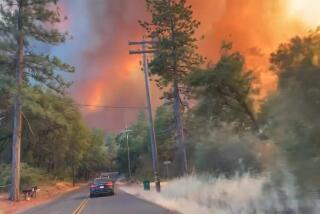California Journal: A bone shard, a molar, an artificial hip — the grim task of finding victims of the California fires

Reporting from Santa Rosa — The Sonoma County Search and Rescue Team arrived Sunday on Dover Court around 2:30 p.m. The neighborhood was gone. There was nothing recognizable as a home, except the chimney, and the rough outlines of a foundation.
They had very little to go on. They knew her name was Mary. She was elderly. And she lived alone.
She had been missing for a week, ever since fire had roared through here, melting or incinerating virtually everything in its path.
Not a thing in this neighborhood was alive anymore.
A buzz filled the air. For a few minutes, a drone hovered, moving back and forth, up and down, above the rubble that had been Mary’s home. Its 3-D photos would document the scene before the team went in.
After the drone landed, searchers in bright orange shirts, gloves and masks walked the perimeter, looking for hazards that might hurt the two cadaver dogs who waited with their handlers, ready to work.
Sgt. Dave Thompson, a 25-year veteran of the Sonoma County Sheriff’s Department, stood to the side, a mask over his face, and watched with a couple of detectives.
Thompson has been in charge of search and rescue for eight years. He trained and took care of the folks who would be poking and sifting through the ash for human remains. There are a total of 50; Sunday, 20 descended on Dover Court.
Thompson, who said some have been doing this work for a decade, did not allow me to interview them. The work can be emotional and he did not want me to distract them. All are community volunteers: bankers, teachers, professors, insurance agents, basketball coaches.
“They are amazing people,” he said.
And yet, given that temperatures had soared as high as 1,500 degrees, what could even the most tenacious searcher hope to find?
Brace yourselves, because this where it gets really grim.
“The best clue for us is bone marrow,” Thompson said. “The bones tend to explode a little bit. They look kind of like a PVC pipe. And you see this porous, darker yellow substance in them. That’s the marrow.”
But bones are easy to confuse with other household items, he said. “Drywall pieces that are cupped and curled can look like ribs,” he said.
At Mary’s house, they would be lucky to find even a 3-inch bone fragment, or part of a vertebra or a tooth. If they were really lucky, they might discover an artificial hip, with a serial number that can be traced.
“Our job is to find the big parts,” Thompson said. After that, he added, the search team withdraws, and detectives move in to gather what they can.
::
In the first two days after the Northern California fires began, 10 Sonoma County operators fielded 10,000 pleas for information, including reports of 1,734 missing persons. As of Monday, the number of missing had plummeted to 88.
The vast majority of missing-people reports have happy endings, said Thompson, who happens to be the officer who eight days ago picked up John and Jan Pascoe, the married couple who survived the fire after six hours in their neighbors’ pool.
“They looked like zombies coming out of the ash,” Thompson said. “They were dressed crazy. They were covered in gray. Their hair was sticking out all over.”
Just after dropping off the Pascoes, Thompson came across a panicked couple in a car. The wife, 41 weeks pregnant, was in labor, moaning in pain. “We got to the hospital, I put her in a wheelchair, wheeled her into the lobby and left,” he said. “Maybe they named the baby after me.”
After that, as the missing-people reports came streaming in, his work took a more gruesome turn. Of the 40 people known to have died in the fires, Thompson’s team has recovered the remains of five.
An hour into the search on Dover Court, when it appeared that the dogs had failed to pick up Mary’s scent, the human team went to work with trek poles, rakes, shovels and sifting boxes.
First, they moved larger objects out of the way, then they sifted, quadrant by quadrant. “Bathrooms, bedrooms, entryways,” Thompson said. “Also vehicles.”
::
For nearly two hours, the team searched diligently for Mary’s remains. One after the other, they would sift debris into buckets, find nothing, then empty the contents away from the house, and start over.
Suddenly, the volunteers erupted in cheers and applause.
Mary had been located. No one seemed to know exactly where, or whom she was with, but she was out there, and alive.
“That’s pretty cool,” Thompson said. “We feel like we just won the war for this particular family.”
On Monday, I was able to track down Mary Priest. I had peeked inside her mailbox, and found a singed piece of paper with her last name.
She is staying with her niece, Monica Kangas, in northwest Santa Rosa. Priest is 91, built her home in the Mark West Springs area with her husband in 1965 and has lived alone since he died 35 years ago.
The night of the fire, she said, she was too panicked to drive, so she fled with neighbors north to Windsor. There, they gathered their wits in a Wal-Mart parking lot with other fire refugees. By late Monday morning, she had checked into a Holiday Inn. On Friday, she moved in with her niece.
Kangas told me she’d alerted authorities right away that her aunt was alive, but in the chaos of the last week, they did not get word.
On Sunday, a neighbor of Priest’s called Kangas: “I heard they are over there searching for Mary, and I heard she is with you!”
Kangas called the sheriff’s department at 4:20 p.m. After hearing the good news, the search team gathered in a circle for a quick chat and put their arms out while someone with a leaf blower cleaned them off. They climbed into their cars and trucks and drove off.
On Monday, Thompson was back in the field with his team. As always, they hope for the best, and are prepared for the worst.

Twitter: @AbcarianLAT
ALSO
They survived six hours in a pool as a wildfire burned their neighborhood to the ground
A family of four tried to outrun the firestorm. Only three made it
More to Read
Sign up for Essential California
The most important California stories and recommendations in your inbox every morning.
You may occasionally receive promotional content from the Los Angeles Times.











